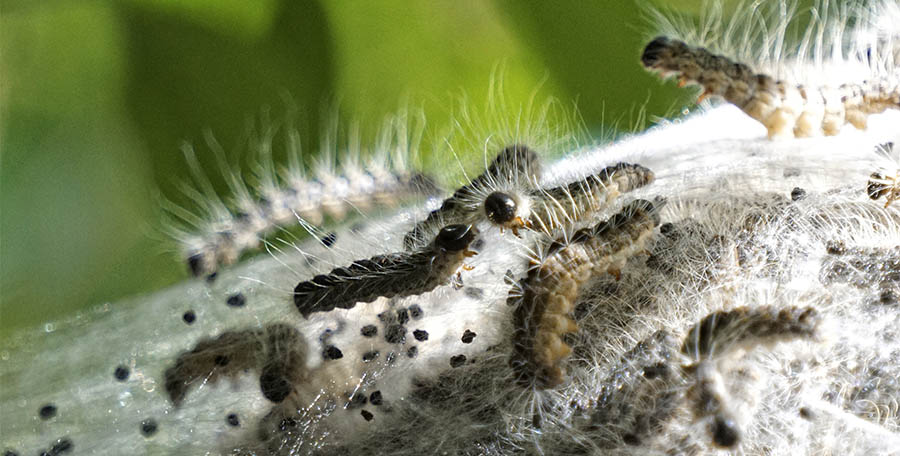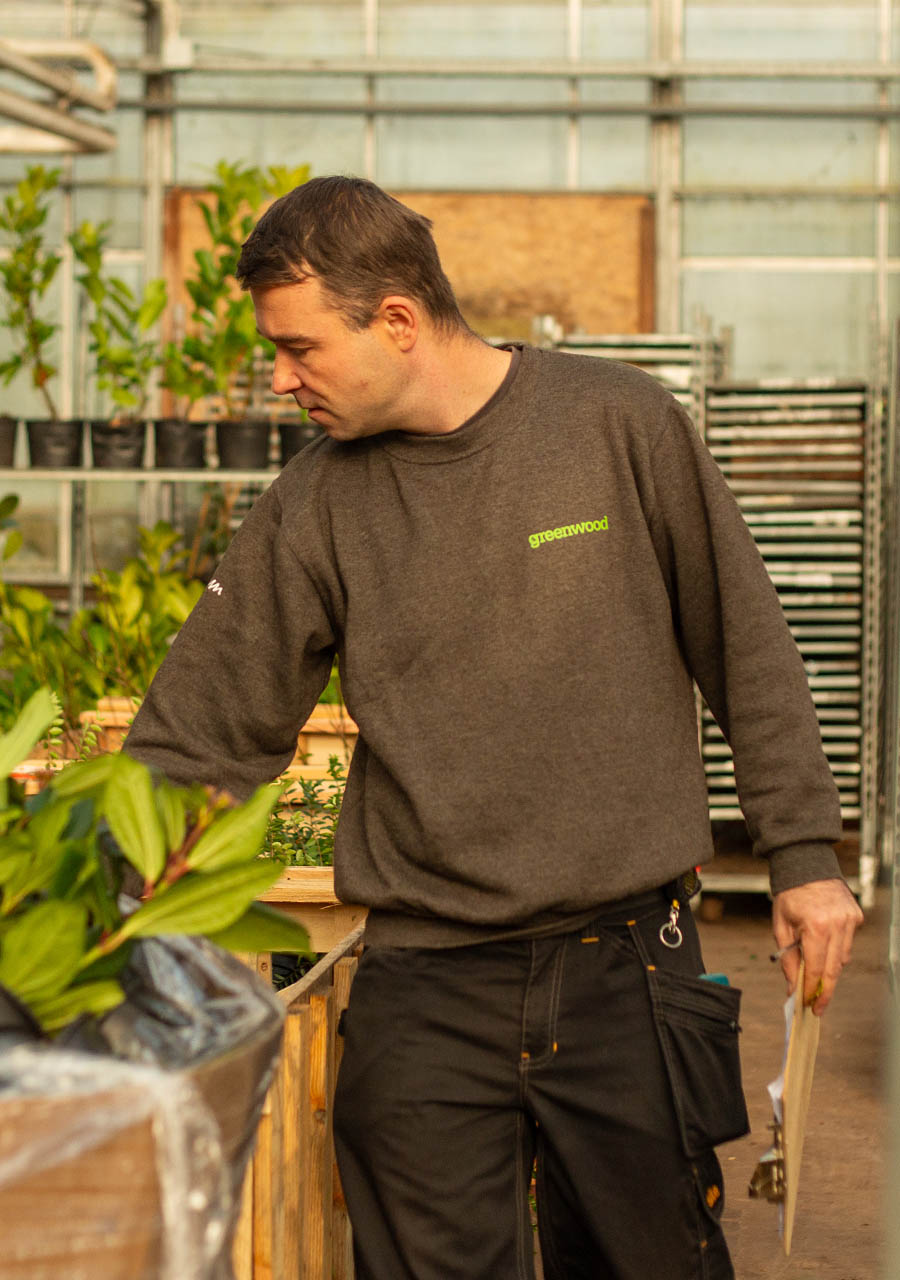The importance of biosecurity
Why plant health matters
The growth of the UK horticultural industry over recent years has been fuelled by the trading of plants from across Europe, as well as further afield. The UK is a major trading partner of key growing markets such as the Netherlands, Belgium, and Italy and this has opened up the market to an exponential variety of species. In trading terms this has huge economic benefits; however, it can present pest and disease risks as part of the importing process. New pests and diseases are a particularly dangerous, as indigenous plants have no built up evolutionary natural immunity to these threats and so they present even more of a risk to plant life and biodiversity than native pests and diseases. This is why biosecurity must be taken seriously, our entire ecosystem depends on it.

Thaumetopoea processionea (oak processionary moth)
Attention towards plant health and biosecurity has grown in recent years, with new controls and measures being brought in to protect crops from pests and diseases. Biosecurity aims to prevent the introduction and spread of organisms harmful to plants, such as insects, bacteria and pathogenic fungi. These organisms can cause serious damage to the natural ecosystems, threatening biodiversity and crop production. The UK has recently implemented new controls and regulations to strengthen plant biosecurity. These measures include stricter controls on imported plant products and a greater focus on plant disease surveillance and management. It is hoped that these measures well reduce the threat of invasive pests and diseases in the UK. In addition to these measures, as responsible growers and importers, there are several measures that can be taken.

Combatting and preventing pests and diseases.
Plant health requires three different types of action to avoid problems:
1) Prevention: day in and day out, plants need to be provided with care, with regular watering, pruning, as well as products that stimulate their growth by boosting their natural defence mechanisms. This includes natural products such as Oenosan, which is lime-based and helps protect plants from diseases as well as allowing it to thrive.
2) Early intervention: By regularly inspecting plants, prompt action can be taken at the first signs of any issues. At this stage, natural preventions and very low-toxicity products can be used, with the purpose of repelling pests. This can include using insects such as Atheta (Dalotia coriaria), that do not feed on the plants themselves, but hunt pests such as sciarid flies that do. In nurseries, timely removal of diseased plants is imperative to saving others from the disease.
3) Treatment of the disease: if the pest or disease causes enough damage to a specimen, it is necessary to intervene with treatments capable of destroying them, while avoiding products that may also harm the environment. An example of this is treating an aphid outbreak with macerated garlic.
Regular plant care includes proper pruning and topping, tailored to their specific needs, and providing the right nutrition, tailored to each species. With this basic care, it will result in plants that are more resistant to pests and diseases.
Controlling irrigation and ambient humidity is essential to keep plants healthy. Keeping the soil too dry or too wet can weaken plants and predispose them to pest attacks. It is also important to meet environmental moisture requirements, such as through spraying on the foliage. Cleanliness and hygiene are crucial in plant management. Plants, whether potted or in the ground, should be kept clean by removing fallen leaves and cleaning the foliage. It is important to disinfect cutting tools after each pruning and to avoid excessive cuts that can weaken plants. It is essential to leave adequate space for the roots and crown development of each plant, avoiding plantings that are too close together or close to walls or fences. This is especially important for trees and shrubs, which grow gradually over time.
To prevent pests or diseases, it is important to watch plants closely in sensitive areas. Often the problem is related to environmental factors such as water, light or substrate. Diseases are often caused by fungi, bacteria or viruses that spread through spores.
It is important to understand the type of problem before choosing the right insecticide or fungicide. Organic insecticides and fungicides can be as effective when used properly as conventional ones. If plants are always well fed, well cared for, and chosen according to environmental and climatic conditions, they will be less susceptible to these invasions.

Biosecurity
In recent years, there has been an increase in insect infestations, as well as fungal, viral and bacterial diseases. The increase has been caused by the increased volume of plants imported into the UK, as well as factors such as climate change enabling different types of invasive organisms to thrive geographical areas that they couldn’t previously tolerate.
Scientists have stated that global warming puts useful insects such as bumblebees, osmias, and other pollinators at risk, while favouring the survival of harmful and nuisance insects such as wasps and beetles. This also creates conditions suited to the life and reproduction of “alien” insects, which usually thrive in habitats other than our own.
Plant pests as aphids, thrips, and mites are much easier to manage than plant diseases as moulds, fungi, and viruses. Plant pests usually only affect ornamental plants from spring until early autumn, while plant diseases can occur at any time of the year. The introduction and spread of non-indigenous pests however, such as fungi, bacteria, viruses and insects, pose a serious threat because of the potential, extreme economic, social and environmental consequences.

Thaumetopoea pityocampa (pine processionary moth)
Biosecurity plays a crucial role in protecting our native plants and the environment. In recent years, the UK has faced devastating effects caused by a range of pests that have emerged from abroad. The trade and movement of plants and trees have been the main source for introduction into new areas. Biosecurity involves taking precautions to prevent the introduction and spread of harmful organisms. Examples of pests include the Thaumetopoea processionea (oak processionary moth), Thaumetopoea pityocampa (pine processionary moth), and the fungus Hymenoscyphus fraxienus, which is responsible for ash dieback. These organisms pose a significant threat to native plants and require concrete actions to minimise the risk of spread. The UK government has initiated monitoring and control programs to manage pest populations, but prevention remains key to protect plant health and the environment. If you would like to learn more about Biosecurity read our blog.
Plant Healthy
The Plant Health Certification Scheme is an important tool in plant biosecurity aimed at protecting ornamental plants and the environment from destructive pests and diseases. Horticultural businesses can be accredited as ‘plant healthy’ by demonstrating their ability to operate to a set of standards that minimises the risk of pest and disease spread. Businesses with ‘Plant Healthy’ accreditation can formally demonstrate their compliance with plant health management standards.
The main objective of the scheme is to reduce the risk of introduction and spread of destructive plant pests through plant supply chains, thereby protecting the horticulture industry, other crop plants and natural habitats. In addition, the scheme aims to easily identify companies and organisations that handle plant material according to high standards of plant health and biosecurity.
The Plant Health Management Standard, on which the certification scheme is based, was developed by specialists from industry, government and non-profit horticultural organisations. The certification system is managed by the Plant Health Alliance, who are committed to ensuring that standards are fit for purpose, based on the latest evidence, and updated regularly to ensure they remain relevant. To support this, a technical advisory group was established to periodically review the Plant Health Management Standard, ensuring that the requirements are aligned with best practices and the latest scientific findings in plant biosecurity.
Requirements in the Plant Health Management Standard include having a clear biosecurity policy, which is widely distributed and adhered to by employees, outlining the commitment to the preservation of biosecurity when importing, growing on nurseries, and dispatching plants and trees. It includes requirements for risk analysis, supply chain management, hygiene and housekeeping, monitoring and assessment, as well as training and recognition for all staff. Only business which can confidently demonstrate their ability to adhere to these requirements will be awarded ‘Plant Healthy’ accreditation.
At Greenwood Plants, we believe that Every Plant Matters and our goal is to make sure every plant on our nurseries, whether grown or imported, can thrive without being plagued by pests or disease. We keep a comprehensive inventory of plant species most susceptible to pests and diseases and we are continually updating it as we deepen our understanding, using it as a tool for ongoing vigilance. Control measures are in place to manage potentially destructive pests. upon identification of new pest risks, immediate and decisive action is taken to contain their spread. The approach goes beyond identification however; we carefully evaluate possible entry points and potential routes of pest spread, through rigorous inspection protocols that are meticulously executed to intercept and contain any emerging issues. Ensuring the G team are prepared, and educated on the biggest risks, is of paramount importance to enforcing a substantial biosecurity policy.
At Greenwood, we remain firmly committed to maintaining phytosanitary standards through the importing of plants, as well as real-time monitoring and ongoing evaluation of the effectiveness of our interventions. We are equipped to resolve any problems caused by the detection of dangerous plant pathogens. Comprehensive biosecurity training ensures that each team member is able to effectively handle any potential situation. Safeguarding our green spaces and maintaining plant health is of the upmost importance and is exemplified in our company slogan: Every Plant Matters.
To find out more about our biosecurity policy, click here.
To read more about Greenwood’s sustainability initiatives, click here.


